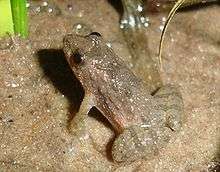Pseudopaludicola
| Pseudopaludicola | |
|---|---|
 | |
| Pseudopaludicola falcipes | |
| Scientific classification | |
| Kingdom: | Animalia |
| Phylum: | Chordata |
| Class: | Amphibia |
| Order: | Anura |
| Family: | Leptodactylidae |
| Subfamily: | Leiuperinae |
| Genus: | Pseudopaludicola Miranda-Ribeiro, 1926 |
| Type species | |
| Liuperus falcipes Hensel, 1867 | |
| Species | |
|
About 18, see text | |
Pseudopaludicola is a genus of leptodactylid frogs from lowland northern and central South America.[1][2] They are known under the common name dwarf swamp frogs or swamp frogs.[1]
Systematics
Pseudopaludicola are small frogs, growing maximally to 22 mm (0.87 in) in snout–vent length. The synapomorphy defining this genus is the greatly enlarged tubercle on the outer edge of the forearm (i.e., hypertrophied antebrachial tubercle).[3] Genetic analyses have recovered this genus as monophyletic, in accordance with earlier studies using morphological characters. Genetic data suggest four major clades within the genus.[2]
Species
Following the Amphibian Species of the World, there are currently 18 species in this genus:[1]
- Pseudopaludicola ameghini (Cope, 1887)
- Pseudopaludicola atragula Pansonato, Mudrek, Veiga-Menoncello, Rossa-Feres, Martins, and Strüssmann, 2014
- Pseudopaludicola boliviana Parker, 1927
- Pseudopaludicola canga Giaretta and Kokubum, 2003
- Pseudopaludicola ceratophyes Rivero and Serna, 1985
- Pseudopaludicola facureae Andrade and Carvalho, 2013
- Pseudopaludicola falcipes (Hensel, 1867)
- Pseudopaludicola giarettai Carvalho, 2012
- Pseudopaludicola hyleaustralis Pansonato, Morais, Ávila, Kawashita-Ribeiro, Strussmann, and Martins, 2012
- Pseudopaludicola llanera Lynch, 1989
- Pseudopaludicola mineira Lobo, 1994
- Pseudopaludicola murundu Toledo, Siqueira, Duarte, Veiga-Menoncello, Recco-Pimentel, and Haddad, 2010
- Pseudopaludicola mystacalis (Cope, 1887)
- Pseudopaludicola parnaiba Robert, Cardozo, and Ávila, 2013
- Pseudopaludicola pocoto Magalhães, Loebmann, Kokubum, Haddad, and Garda, 2014
- Pseudopaludicola pusilla (Ruthven, 1916)
- Pseudopaludicola saltica (Cope, 1887)
- Pseudopaludicola ternetzi Miranda-Ribeiro, 1937
The Amphibiaweb also list Pseudopaludicola serrana,[4] whereas the Amphibian Species of the World considers it synonym of Pseudopaludicola murundu.[1]
References
- 1 2 3 4 Frost, Darrel R. (2016). "Pseudopaludicola Miranda-Ribeiro, 1926". Amphibian Species of the World: an Online Reference. Version 6.0. American Museum of Natural History. Retrieved 23 February 2016.
- 1 2 Veiga-Menoncello, Ana C. P.; Lourenço, Luciana B.; Strüssmann, Christine; Rossa-Feres, Denise C.; Andrade, Gilda V.; Giaretta, Ariovaldo A.; Recco-Pimentel, Shirlei M. (2014). "A phylogenetic analysis of Pseudopaludicola (Anura) providing evidence of progressive chromosome reduction". Zoologica Scripta. 43 (3): 261–272. doi:10.1111/zsc.12048.
- ↑ Lynch, John D. (1989). "A Review of the leptodactylid frogs of the genus Pseudopaludicola in northern South America". Copeia. 1989 (3): 577–588. doi:10.2307/1445483.
- ↑ "Leptodactylidae". AmphibiaWeb: Information on amphibian biology and conservation. [web application]. Berkeley, California: AmphibiaWeb. 2016. Retrieved 23 February 2016.